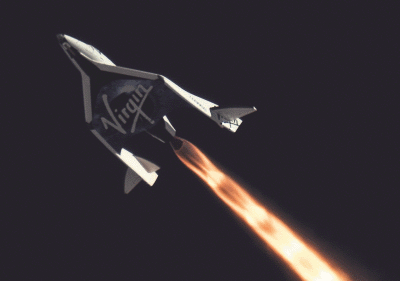Mon, May 26, 2014
Flights To An Altitude Of 50 Miles Do Not Reach The 'Karman Line'
There is a line in the sky that is recognized as the boundary between the Earth's atmosphere and "space" ... and Sir Richard Branson's SpaceShipTwo may not get passengers all the way to the line.

But the invisible threshold of space may not be Branson's most immediate concern. What may be is the report of cracks that have formed in the wings of WhiteKnightTwo, the aircraft that will carry SpaceShipTwo for launch.
The London Sunday Times reported recently that a Virgin Galactic insider said that sources with knowledge of the situation indicated that multiple cracks had formed in the wings of the aircraft, but Virgin Galactic has denied any problem with the aircraft. A company spokesman said that the aircraft had been taken out of service for its annual inspection, but "there are NO cracks in the wings." The spokesperson did say that some "adhesive imperfections which are often produced in the composite manufacturing process" had to be repaired. But those imperfections had a "negligible impact" on the performance of the aircraft.
Meanwhile, back to that invisible line. Virgin Galactic promises those who have paid up to a quarter million dollars for their opportunity to go to "space" may not fly high enough to officially get there. The "Karman Line" marking the beginning of space is considered to be 62 miles above Mean Sea Level, but VG only promises that passengers will travel to an altitude of "at least 50 miles" aboard SpaceShipTwo. The International Business Times reports that Branson and Virgin Galactic say that NASA has recognized the 50 mile altitude to be "space" since the 1960s. Astronaut wings have been awarded by NASA to pilots who flew to 50 miles as recently as 2005.

But not according to the World Air Sports Federation, the governing body for astronautical world records. While passengers flying at 50 miles will be able to experience weightlessness, the WASF will not certify that they have been to space unless they pass the 62-mile Karman Line.
Virgin Galactic CEO George Whitesides told the International Business Times that "NASA and the U.S. Air Force have a long tradition of celebrating everything above 50 miles as spaceflight, and we look forward to joining those ranks as soon as we push onward and upward. We are still targeting 100 kilometers (62 miles)."
(Images from file)
More News
With Testing Soon Complete, Launch Preparations Begin in Earnest Sierra Space's Dream Chaser has been put through the wringer at NASA's Glenn Armstrong Test Facility in Ohio, but w>[...]
Takeoff Roll The process whereby an aircraft is aligned with the runway centerline and the aircraft is moving with the intent to take off. For helicopters, this pertains to the act>[...]
“We’re proud of the hard work that went into receiving this validation, and it will be a welcome relief to our customers in the European Union. We couldn’t be mor>[...]
"Aircraft Spruce is pleased to announce the acquisition of the parts distribution operations of Wag-Aero. Wag-Aero was founded in the 1960’s by Dick and Bobbie Wagner in the >[...]
IDENT Feature The special feature in the Air Traffic Control Radar Beacon System (ATCRBS) equipment. It is used to immediately distinguish one displayed beacon target from other be>[...]
 Sierra Space Repositions Dream Chaser for First Mission
Sierra Space Repositions Dream Chaser for First Mission ANN's Daily Aero-Term (05.10.24): Takeoff Roll
ANN's Daily Aero-Term (05.10.24): Takeoff Roll Aero-News: Quote of the Day (05.10.24)
Aero-News: Quote of the Day (05.10.24) Aero-News: Quote of the Day (05.11.24)
Aero-News: Quote of the Day (05.11.24) ANN's Daily Aero-Term (05.11.24): IDENT Feature
ANN's Daily Aero-Term (05.11.24): IDENT Feature




